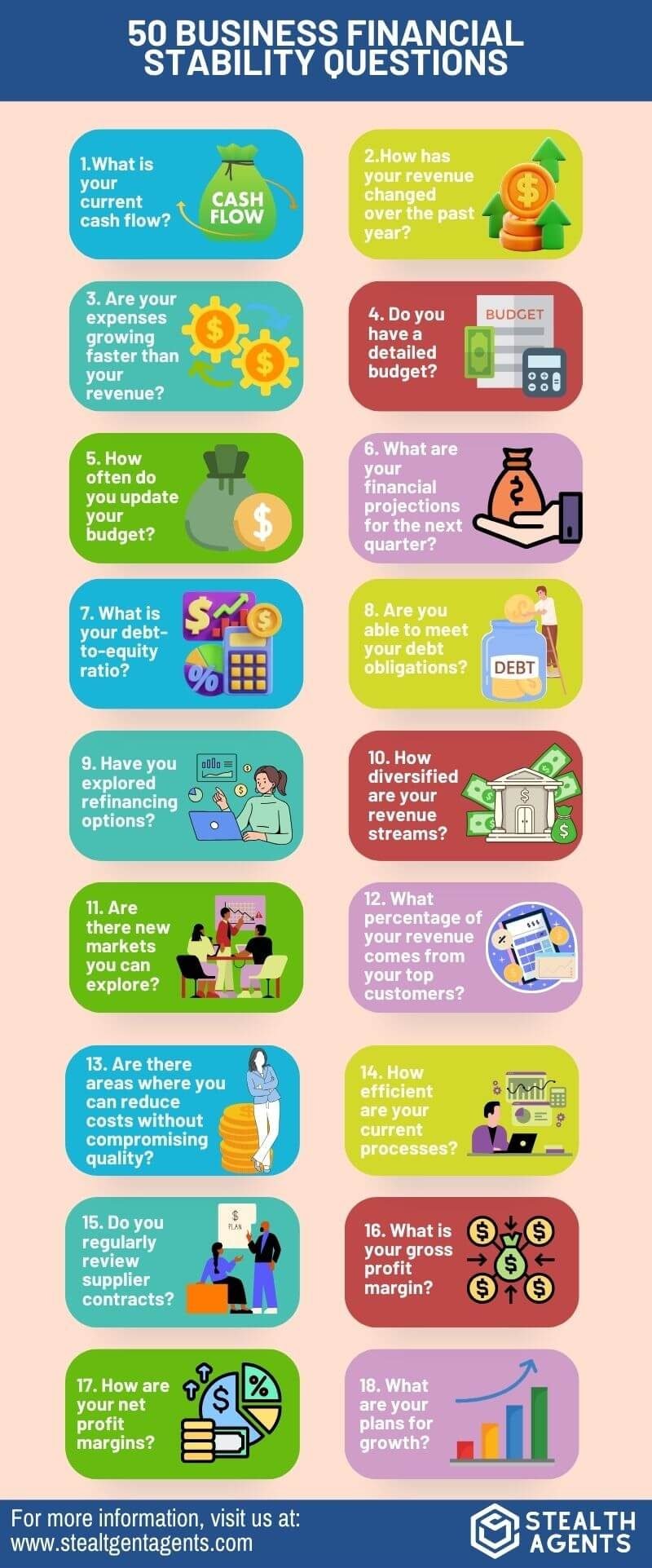Running a business is like steering a ship through unpredictable waters.
To ensure financial stability, business owners and managers need to regularly check their company’s financial health.
This means asking the right questions, understanding financial details, and applying strategies for long-term success.
Whether you’re a small business owner or managing finances, this guide covers 50 key questions every smart business leader should ask.
What is financial health?
Financial health refers to the overall stability and well-being of a company’s finances.
It indicates how well a business can meet its financial obligations and continue operations.
Assessing financial health involves asking financial questions to a business owner about revenue, expenses, and cash flow.
Key indicators include the financial stability of a company and its ability to generate profit consistently.
Evaluating business financial health also involves questions about business finance, such as debt levels and asset management.
Business finance questions are crucial in determining company stability and potential growth.
In essence, financial health provides a snapshot of a company’s economic strength and future prospects.
How Do You Assess Financial Stability?
1. Evaluate Your Business Financial Status Regularly
To assess financial stability, start by examining your business financial status.
This involves reviewing balance sheets, income statements, and cash flow statements to understand the overall financial health of a company.
A financial stability survey questionnaire can help pinpoint areas needing improvement and track progress.
By frequently checking finances with a virtual assistant reviewing these documents, you get a clear picture of company finances and can make informed decisions.
2. Conduct a Financial Health Analysis
Performing a financial health analysis is crucial in understanding the fiscal health meaning of your business.
This analysis examines key financial ratios such as liquidity, profitability, and solvency, giving insights into the financial status.
Helps identify financially healthy companies and benchmark your company financial health against industry standards.
Regular analysis ensures you maintain good business financial health.
3. Monitor Cash Flow for Company Finances
Cash flow management is key to assessing the financial health of a company.
Tracking inflows and outflows helps you understand your current financial status and predict future financial conditions.
Consistent monitoring aids in preventing potential cash shortages, which are corporate finance essentials, and ensures your company remains financially stable.
Staying on top of cash flow is essential for maintaining steady company finances.
4. Compare with Industry Benchmarks for Financially Healthy Companies
Benchmarking against financially healthy companies can provide valuable insights into your financial stability.
This involves comparing financial ratios and metrics against industry standards to evaluate where your business stands
Understanding these comparisons highlights strengths and areas for improvement in your company financial health.
This proactive approach keeps your business aligned with fiscal health meaning and expectations.
5. Usee a Financial Stability Survey Questionnaire
A financial stability survey questionnaire can be a useful tool in assessing a business’s financial health and financial documentaries.
These surveys provide a structured way to gather information about your financial status and identify potential risks.
They offer a comprehensive view of the financial health of a company, helping to identify areas needing attention.
Regular use of such questionnaires ensures you maintain a clear perspective on your business financial stability.
Why Financial Stability Matters?
Financial stability in business means having a solid foundation that can withstand economic fluctuations.
It allows businesses to invest, grow, and weather financial storms.
Without business stability, businesses are at risk of unexpected downturns, making it crucial to regularly assess and improve your financial health.
Business Financial Stability Questions
Here are some financial stability questionnaires that you must consider for every decision you make in financing.
Assessing Your Current Financial Situation
1. What is your current cash flow?
Understanding your cash flow is the first step toward financial stability. Positive cash flow ensures you can meet your obligations and invest in growth opportunities.
2. How has your revenue changed over the past year?
Tracking revenue changes helps identify trends and areas of concern or opportunity. This information can guide strategic decisions.
3. Are your expenses growing faster than your revenue?
If expenses outpace revenue, it may indicate inefficiencies or potential financial trouble. Regularly review and adjust your spending to align with income.
Budgeting and Forecasting
4. Do you have a detailed budget?
A comprehensive budget outlines expected revenue and expenses, helping you plan for the future and avoid overspending.
5. How often do you update your budget?
Regular updates ensure your budget reflects current realities, allowing for timely adjustments and better financial control.
6. What are your financial projections for the next quarter?
Projections help anticipate future financial needs and guide planning efforts. They should be based on current data and realistic assumptions.
Managing Debt and Liabilities
7. What is your debt-to-equity ratio?
This ratio indicates the balance between debt and equity financing. A high ratio may signal excessive debt, while a low ratio suggests reliance on equity.
8. Are you able to meet your debt obligations?
Regularly reviewing your ability to service debt ensures you can avoid defaults and maintain good credit standing.
9. Have you explored refinancing options?
Refinancing can lower interest rates and improve cash flow, making it a viable option for managing debt more effectively.
Revenue Streams and Diversification
10. How diversified are your revenue streams?
Diversification reduces reliance on a single income source, spreading risk and increasing stability.
11. Are there new markets you can explore?
Entering new markets can provide additional revenue streams and growth opportunities, enhancing overall financial stability.
12. What percentage of your revenue comes from your top customers?
Relying heavily on a few customers can be risky. Diversifying your customer base can protect against unexpected revenue loss.
Cost Management and Efficiency
13. Are there areas where you can reduce costs without compromising quality?
Identifying and eliminating unnecessary expenses can improve your bottom line without affecting product or service quality.
14. How efficient are your current processes?
Streamlined processes reduce waste and improve efficiency, contributing to better financial health.
15. Do you regularly review supplier contracts?
Negotiating better terms with suppliers can lower costs and improve cash flow. Regular reviews ensure you’re getting the best deals.
Profitability and Growth
16. What is your gross profit margin?
This metric helps assess the profitability of your products or services. A healthy margin indicates effective cost management.
17. How are your net profit margins?
Net profit margins reflect overall profitability after all expenses. Monitoring this metric helps ensure long-term sustainability.
18. What are your plans for growth?
Strategic growth plans guide investment decisions and help allocate resources effectively, supporting financial stability.

Customer Acquisition and Retention
19. What is your customer acquisition cost (CAC)?
Understanding CAC helps assess the efficiency of your marketing efforts and the profitability of new customers.
20. How high is your customer retention rate?
High retention rates indicate customer satisfaction and loyalty, contributing to stable revenue streams.
21. Do you have a customer loyalty program?
Loyalty programs incentivize repeat business, enhancing customer retention and long-term revenue.
Inventory Management
22. How often do you review your inventory levels?
Regular reviews ensure optimal inventory levels, reducing carrying costs and stockouts.
23. What is your inventory turnover rate?
High turnover rates indicate efficient inventory management, while low rates may signal overstocking or slow-moving items.
24. Are there ways to optimize your supply chain?
Improving supply chain efficiency can lower costs and enhance overall financial stability.
Financial Reporting and Analysis
25. Do you generate regular financial reports?
Timely financial reports provide insights into your business’s performance, aiding in strategic decision-making.
26. How accurate are your financial statements?
Accurate statements ensure reliable data for analysis and planning, supporting sound financial decisions.
27. Do you use financial ratios to assess performance?
Ratios like liquidity, profitability, and solvency provide a comprehensive view of your financial health.
Investment and Capital Allocation
28. How do you decide on capital investments?
Strategic investments in high-return areas support growth and financial stability.
29. Are you reinvesting profits back into the business?
Reinvesting profits fuels growth and innovation, enhancing long-term stability.
30. How do you manage your working capital?
Efficient working capital management ensures you can meet short-term obligations and invest in opportunities.
Risk Management
31. Do you have a risk management plan?
Identifying and mitigating risks protects your business from unforeseen events, supporting stability.
32. How do you handle financial emergencies?
Having a contingency plan in place ensures swift and effective responses to financial crises.
33. Are you adequately insured?
Insurance protects against significant financial losses, contributing to overall stability.
Tax Planning and Compliance
34. Are you up-to-date with tax obligations?
Timely tax payments avoid penalties and interest, preserving financial resources.
35. Do you have a tax planning strategy?
Effective tax planning minimizes liabilities and maximizes savings, improving financial health.
36. Are you taking advantage of available tax incentives?
Utilizing tax incentives reduces overall tax burden, freeing up resources for other areas.

Employee and Payroll Management
37. How do you manage payroll expenses?
Efficient payroll management ensures fair compensation while controlling costs.
38. Are you offering competitive benefits?
Competitive benefits attract and retain top talent, supporting business growth.
39. How do you assess employee performance?
Regular performance reviews ensure employees contribute effectively to business goals.
Technology and Innovation
40. Are you leveraging technology to improve efficiency?
Adopting new technologies can streamline operations and reduce costs, enhancing financial stability.
41. How do you stay updated on industry innovations?
Staying informed about industry trends and innovations supports strategic planning and competitiveness.
42. Are you investing in cybersecurity?
Protecting your business from cyber threats preserves financial resources and reputational integrity.
Strategic Partnerships
43. Do you have strategic partnerships in place?
Partnerships can provide access to new markets, resources, and expertise, supporting growth and stability.
44. How do you manage vendor relationships?
Strong vendor relationships ensure reliable supply chains and favorable terms, contributing to financial health.
45. Are you collaborating with other businesses?
Collaborations can drive innovation and growth, enhancing overall stability.
Succession Planning
46. Do you have a succession plan?
A clear succession plan ensures business continuity and stability in leadership transitions.
47. How do you identify potential leaders?
Identifying and developing future leaders supports long-term business success.
48. Are you preparing for potential exits?
Planning for exits, whether through sale or succession, ensures smooth transitions and preserves value.
Community and Social Responsibility
49. Are you engaging with your local community?
Community engagement builds brand loyalty and enhances business reputation, supporting long-term success.
50. How are you addressing social responsibility?
Demonstrating social responsibility enhances a company’s reputation and fosters trust with stakeholders, paving the way for sustainable growth and success.

Takeaways
Ensuring your business’s financial stability requires ongoing effort and vigilance.
By asking and answering these 50 essential questions, you can gain a deeper understanding of your financial health and make informed decisions to drive growth and success.
Remember, financial stability is not a one-time achievement but a continuous process.
Stay proactive, adapt to changing conditions, and prioritize financial planning to secure your business’s future.
For further guidance and personalized support, consider reaching out to a financial advisor or business consultant.
These steps can set the foundation for a prosperous and resilient business.













